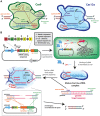New Applications of Synthetic Biology Tools for Cyanobacterial Metabolic Engineering
- PMID: 30873404
- PMCID: PMC6400836
- DOI: 10.3389/fbioe.2019.00033
New Applications of Synthetic Biology Tools for Cyanobacterial Metabolic Engineering
Abstract
Cyanobacteria are promising microorganisms for sustainable biotechnologies, yet unlocking their potential requires radical re-engineering and application of cutting-edge synthetic biology techniques. In recent years, the available devices and strategies for modifying cyanobacteria have been increasing, including advances in the design of genetic promoters, ribosome binding sites, riboswitches, reporter proteins, modular vector systems, and markerless selection systems. Because of these new toolkits, cyanobacteria have been successfully engineered to express heterologous pathways for the production of a wide variety of valuable compounds. Cyanobacterial strains with the potential to be used in real-world applications will require the refinement of genetic circuits used to express the heterologous pathways and development of accurate models that predict how these pathways can be best integrated into the larger cellular metabolic network. Herein, we review advances that have been made to translate synthetic biology tools into cyanobacterial model organisms and summarize experimental and in silico strategies that have been employed to increase their bioproduction potential. Despite the advances in synthetic biology and metabolic engineering during the last years, it is clear that still further improvements are required if cyanobacteria are to be competitive with heterotrophic microorganisms for the bioproduction of added-value compounds.
Keywords: cyanobacteria; genome scale models; metabolic engineering; photosynthesis; synthetic biology.
Figures




Similar articles
-
Recent advances in synthetic biology of cyanobacteria for improved chemicals production.Bioengineered. 2020 Dec;11(1):1208-1220. doi: 10.1080/21655979.2020.1837458. Bioengineered. 2020. PMID: 33124500 Free PMC article. Review.
-
The current situations and limitations of genetic engineering in cyanobacteria: a mini review.Mol Biol Rep. 2023 Jun;50(6):5481-5487. doi: 10.1007/s11033-023-08456-8. Epub 2023 Apr 29. Mol Biol Rep. 2023. PMID: 37119415 Review.
-
Toolboxes for cyanobacteria: Recent advances and future direction.Biotechnol Adv. 2018 Jul-Aug;36(4):1293-1307. doi: 10.1016/j.biotechadv.2018.04.007. Epub 2018 May 3. Biotechnol Adv. 2018. PMID: 29729377 Review.
-
Current Metabolic Engineering Strategies for Photosynthetic Bioproduction in Cyanobacteria.Microorganisms. 2023 Feb 11;11(2):455. doi: 10.3390/microorganisms11020455. Microorganisms. 2023. PMID: 36838420 Free PMC article. Review.
-
Synthetic Biology Toolkits for Metabolic Engineering of Cyanobacteria.Biotechnol J. 2019 Jun;14(6):e1800496. doi: 10.1002/biot.201800496. Epub 2019 May 17. Biotechnol J. 2019. PMID: 30927496 Review.
Cited by
-
Rubisco regulation in response to altered carbon status in the cyanobacterium Synechococcus elongatus PCC 7942.Plant Physiol. 2022 Jun 1;189(2):874-888. doi: 10.1093/plphys/kiac065. Plant Physiol. 2022. PMID: 35201348 Free PMC article.
-
Reprogramming Microbial CO2-Metabolizing Chassis With CRISPR-Cas Systems.Front Bioeng Biotechnol. 2022 Jun 23;10:897204. doi: 10.3389/fbioe.2022.897204. eCollection 2022. Front Bioeng Biotechnol. 2022. PMID: 35814004 Free PMC article. Review.
-
Absence of increased genomic variants in the cyanobacterium Chroococcidiopsis exposed to Mars-like conditions outside the space station.Sci Rep. 2022 May 19;12(1):8437. doi: 10.1038/s41598-022-12631-5. Sci Rep. 2022. PMID: 35589950 Free PMC article.
-
Evaluating scaling of capillary photo-biofilm reactors for high cell density cultivation of mixed trophies artificial microbial consortia.Eng Life Sci. 2023 Jun 23;23(9):e2300014. doi: 10.1002/elsc.202300014. eCollection 2023 Sep. Eng Life Sci. 2023. PMID: 37664011 Free PMC article.
-
Expression and activity of heterologous hydroxyisocaproate dehydrogenases in Synechocystis sp. PCC 6803 ΔhoxYH.Eng Microbiol. 2021 Nov 26;2(1):100008. doi: 10.1016/j.engmic.2021.100008. eCollection 2022 Mar. Eng Microbiol. 2021. PMID: 39628613 Free PMC article.
References
-
- Acién F. G., Molina E., Reis A., Torzillo G., Zittelli G. C., Sepúlveda C., et al. (2017). Photobioreactors for the production of microalgae, in Microalgae-Based Biofuels and Bioproducts, eds Gonzalez-Fernandez C., Muñoz R. (Kidlington: Woodhead Publishing; ), 1–44.
Publication types
LinkOut - more resources
Full Text Sources
Other Literature Sources

